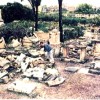
Formerly known as the Msida Bastion Cemetery, this served as a Protestant cemetery from 1806-56. It was restored over a period of ten years and was awarded the Silver Medal by Europa Nostra in 2002. A small museum was added in 2004.
This was the main Protestant cemetery in Malta for about fifty years from 1806. Records show that at least 528 people were buried here and it was more or less full in 1856 when Ta’ Braxia Cemetery was opened. The principal occupants are British servicemen, officials and businessmen and their families, some of whose descendants still live in Malta today, as well as some Maltese.
The most famous Maltese buried here was Mikiel Anton Vassalli, known as the father of the Maltese language, who died on 12 Jan 1829, aged about 64. He was not on good terms with the local Catholic church and had translated the New Testament into Maltese against the wishes of the church. His wife was later also buried here in 1851.
The cemetery lies in the bastion formerly known as St Philip’s Bastion, part of Floriani’s outer defence works commissioned by Grand Master Antoine de Paule in 1635. On the higher ground above the bastion stood the gallows used by the Order. During World War Two the Cemetery was hit by bombs and part of the bastion wall at the far end and some graves were damaged.
The Cemetery was protected by a low wall until 1988 and much was vandalised and destroyed by wind and weather. Vegetation covered the graves and split the stones apart. In 1930 Capt Charles Zammit in his report on this cemetery commented that the great majority of the inscriptions were damaged and indecipherable. In 1988 the Minister of Education, Dr Ugo Mifsud Bonnici declared that the site was to be restored and opened to the public as a garden. A high wall and gate were built and extensive work was carried out by volunteers from Din l-Art Helwa. The original project leader, Mr R.G. Kirkpatrick died in 1988 and interest waned but in 1993 Dr Andy Welsh revived interest in the project and work proceeded steadily thereafter.
The restoration was awarded the Silver Medal by Europa Nostra in 2002. In 2004 a small Museum of Maltese Burial Practices was opened in the building adjacent to the garden by the Minister of Tourism and Culture Dr. Francis Zammit Dimech and Director General of the National Trust of England, Wales and Northern Ireland Mrs. Fiona Reynolds.
The Garden of Rest is open to visitors from Monday to Saturday and the first Sundays of the month, from 9.30 am to 12.00 noon. Admission is free.
The Garden will be closed on 25th December, 1st January and Easter Sunday.






Comments are closed.